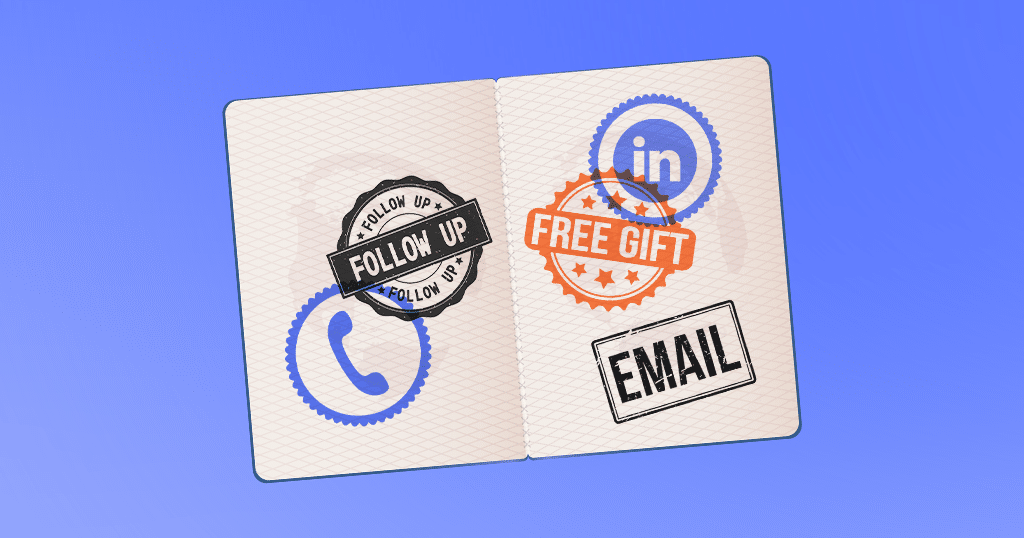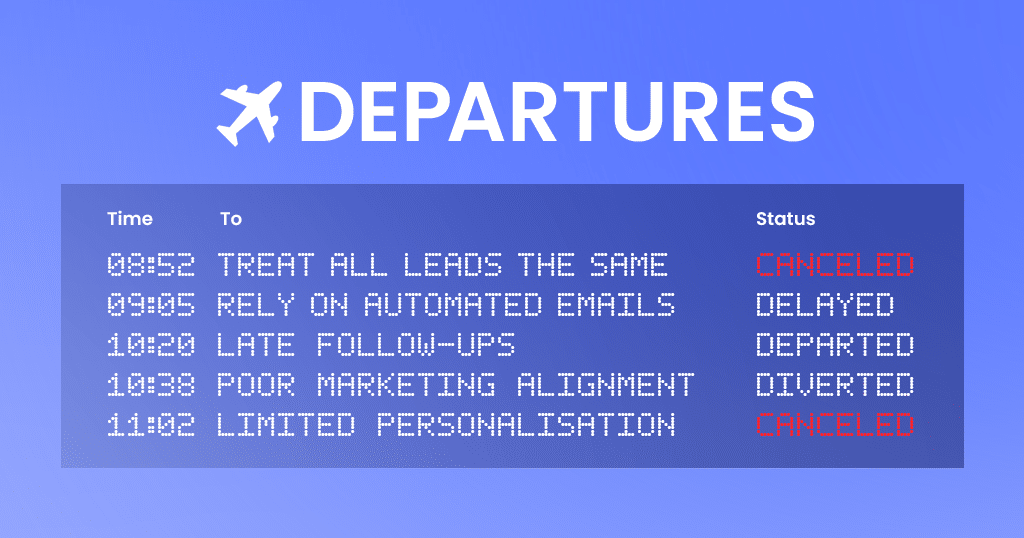At a glance:
- Respond to leads within one hour for 7x higher conversion rates.
- Implement a multi-channel approach using phone, video, email, and LinkedIn.
- Use clear qualification criteria to validate decision authority, budget, and timeline.
- Deploy technology that enables personalisation at scale and provides actionable intelligence.
MQL to SQL conversion isn’t just about having a “process” — it’s about having the right process, executed flawlessly, with the right people, right tools, and right now.
So let’s break down what actually works, based on real results we’ve seen at Punch! (not just theory that sounds good in a PowerPoint).
The Golden Hour
You’re at a networking event. Someone walks up, shows genuine interest in what you do, asks thoughtful questions, then hands you their card saying, “I’d love to chat more about this!”
Do you:
A) Wait 3 days to call them
B) Send a thoughtful follow-up email within 24-48 hours while you’re still fresh in their mind
If you picked A, you’re leaving opportunities on the table.
This networking scenario requires a different approach than responding to inbound leads. For actual sales leads who’ve taken action:
In our work with Lumi, we found that following up with inbound leads within the first hour increased conversion rates by 7X. Not 7%. SEVEN TIMES.
Why? Because timing isn’t just important, it’s everything.
When someone raises their hand to say they’re interested by downloading content or submitting a form, they’re in a buying mindset RIGHT NOW. Every minute that passes is a minute where their enthusiasm cools, distractions mount, and competitors can swoop in.
(That executive who downloaded your whitepaper? They probably downloaded your competitor’s too. First one to call wins.)

The Multi-Channel Symphony
Email follow-up alone is like trying to cut down a tree with a butter knife. Possible, but painfully inefficient.
Here’s what an effective multi-channel strategy actually looks like:
- Immediate phone call (within that golden first hour)
- Personalized video if they don’t answer (using a tool like Vidyard or Loom)
- Targeted email referencing specific pain points
- LinkedIn engagement (comment on their recent post, not just a connection request)
- Strategic gifting for high-value prospects (we use the Barney platform for this)
I once worked with an SDR who was struggling with email-only outreach. His conversion rate was hovering around 2%. We implemented this multi-channel approach and within two weeks, he was converting at 11%.
The reason? Different people respond to different channels. Some execs never check their own email. Others screen all calls. By diversifying, you’re dramatically increasing your chances of breaking through.
The Qualification Framework That Actually Works
I once spent two weeks nurturing what I thought was a hot lead, scheduled three demos, and even flew to their office, only to discover they had absolutely zero budget and no decision-making authority.
That’s when I learned the importance of a rock-solid qualification framework.
Here’s the framework we use at Punch! that’s helped us generate 56 SQLs in 4 months for Lumi:
PACT Framework for Sales Qualification
- Pain:
What specific pain points are you experiencing? How long have you been dealing with them? What happens if you do nothing about these issues? - Authority:
Who else needs to be involved in the decision? (Notice we don’t directly ask if they’re the decision-maker — that puts people on the defensive) - Consequence:
Is solving this problem a financial priority? Where does this rank among other initiatives? What business outcomes are at risk if this isn’t addressed? - Timeline:
By when do you want to start seeing results? What deadlines or milestones are driving your timeline for implementation?
The Tech Stack
You can have the best process in the world, but without the right tech, you’re bringing a knife to a gunfight.
At Punch!, we use our Priority ABX™ platform to:
- Detect real-time buying signals (like when a prospect visits your pricing page 3 times in a week)
- Track engagement across channels (so you know if they opened your email before you call)
- Identify high-intent accounts (so you focus your energy where it matters)
- Enable personalized outreach at scale (because generic templates = generic results)
I remember implementing this tech stack with a client who was manually tracking everything in spreadsheets (the horror). Their lead response time went from 27 hours to under 45 minutes, and their conversion rate nearly tripled in the first month.
The right tech doesn’t replace human interaction — it enhances it by ensuring you’re talking to the right people, at the right time, with the right message.
The Content Nurture Strategy
Raise your hand if you’ve ever sent an email that said, “Just checking in to see if you had a chance to review my proposal.”
(My hand is raised too. We’ve all been there.)
But let’s be honest — that approach sucks. It adds zero value and makes you sound desperate.
Instead, each touchpoint should deliver value through thoughtful content and insights:
- Personalized video walkthroughs (addressing specific pain points)
- Case studies of similar companies (showing tangible results)
- Industry insights relevant to their specific challenges
- ROI calculators tailored to their business metrics
- Micro-demos focusing on features that solve their unique problems
The Metrics That Matter
If you can’t measure it, you can’t improve it. But I’ve seen companies track so many vanity metrics that they lose sight of what actually matters.
Here are the KPIs we’ve found to be most predictive of success:
- Speed to lead contact (targeting under 1 hour)
- Multi-channel engagement rate (percentage of leads engaged across multiple channels)
- Meeting show rate (not just bookings — actual attendance)
- SQL conversion percentage (obviously)
- Pipeline value generated (because quality matters more than quantity)
We worked with Basware and generated £760,000 in pipeline in just 3 months by obsessively focusing on these metrics and optimising accordingly.

The Pitfalls
I’ve seen companies make the same mistakes over and over when it comes to MQL to SQL conversion:
- Treating all leads the same (high-intent leads deserve VIP treatment)
- Relying on automated emails only (the “set it and forget it” approach rarely works)
- Delayed follow-up (anything over an hour and you’re already behind)
- Poor sales-marketing alignment (when sales doesn’t trust marketing’s leads, everyone loses)
- Insufficient personalization (generic outreach = generic results)
I once consulted for a company that was sending the exact same follow-up email to every lead, regardless of source, industry, or behavior. When we implemented segment-specific nurturing sequences, their conversion rate jumped from 3% to 12% in a single quarter.
Putting It All Together
The secret sauce isn’t in any one of these elements — it’s in how they all work together as a cohesive system:
- Lead comes in and is immediately routed to the right SDR based on territory/industry
- SDR responds within the golden hour across multiple channels
- Lead is qualified using the BANT+P framework
- Personalized nurture content is deployed based on specific pain points
- Technology tracks engagement and surfaces buying signals
- Performance is measured against key metrics and continuously optimized
This isn’t theoretical — this is exactly what we did for Nutritics to generate 200+ high-value leads in 7 months and for HUT 3 to create 100+ qualified opportunities from event follow-up.
The Bottom Line
Most companies are leaving 50-70% of potential conversions on the table due to poor process, slow response times, and generic follow-up.
The companies that win are the ones that treat MQL to SQL conversion as a systematic, measurable process that requires dedicated resources, clear criteria, and continuous optimization.
So, what’s your follow-up process looking like? Are you letting good leads slip through the cracks? Or are you ready to implement a system that actually works?
Your pipeline is waiting.


